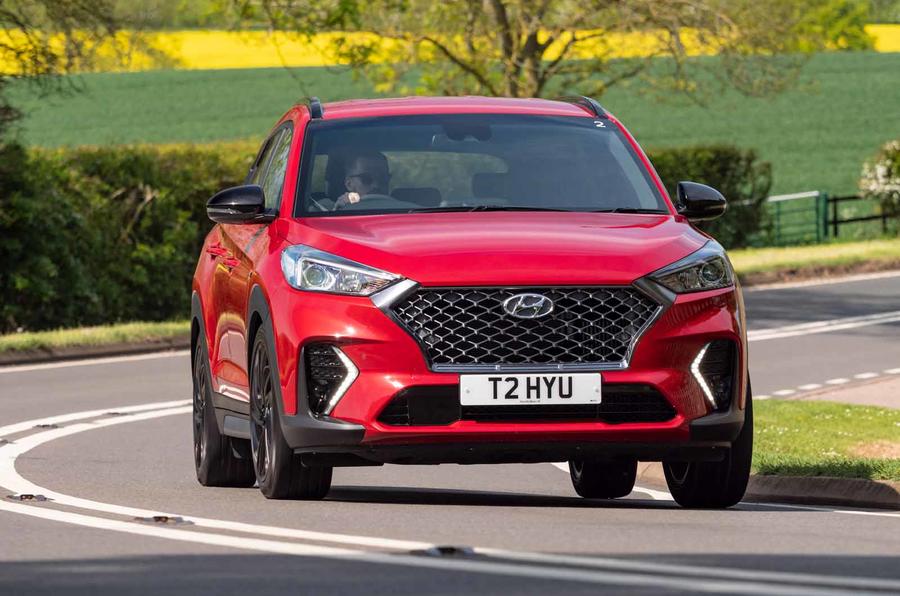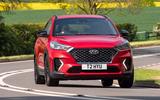What is it?
Here we have another example of Hyundai’s halfway-house sporting trim line, applied to the brand’s big-selling family SUV. We first sampled the delights of N-Line last year in the i30, bridging the market gap between the fizzing heat of the i30 N and the stark tepidity of the regular hatchback.
This doesn’t apply to the Hyundai Tucson, however - at least for the time being. Word on the street is that a full-fat Cupra Ateca rival is in the works, but that’s a good year away at the very least. So, if you want a sporty Tucson, here’s your lot for now. Think Volkswagen’s R-Line and Ford’s ST-Line trims to understand the intention.
However, perhaps even 'sporty' is an adjective too far for the particular variant we’re testing here: the fleet-friendly 1.6-litre diesel, which is boosted by a recently introduced 48V mild hybrid system. Thankfully, you can also have a 174bhp 1.6-litre turbo petrol engine.
Most of the appeal here is visual, then. There’s black detailing everywhere, black 19in alloy wheels, a unique LED daytime running light design and bespoke bumpers. As well as some familiar N brand touches inside, including red leather stitching, there are more supportive seats and the same gearknob as the i30 N.
Hyundai claims a bit of dynamic substance here, though; the suspension is lightly tweaked for tighter body control, while the software calibration of the steering is revised with the aim of giving “a more direct, linear feel”.
What's it like?
This car is as good as it needs to be, for Hyundai at least, given that most customers in this segment aren’t generally all that fussed about a sparkling driving experience.
The standard Tucson is entirely inoffensive to drive, and with the minor changes made under the skin here, there are no great revelations.
The diesel engine is the very definition of a modest performer. Its torque advantage over the petrol should give it reasonable reserves of low-down urge, but even though that means you’re not thumping it towards the redline out of every junction, you’ll soon become familiar with the end of the throttle pedal’s travel just to keep up with the pace of rush-hour motorists.
Doing so isn’t too unpleasant, because the unit is a good deal more refined than the rattly old 1.7-litre, but it’s hardly thrilling. Given you’ll be stirring it in often, the manual gearbox is at least fairly satisfying to operate. Either way, this doesn’t feel like an appropriate powertrain for a sportified model.
As with the multitude of mild hybrid systems we’ve experienced over the past couple of years, the Tucson's operates largely inperceptibly. Hyundai claims the little 0.44kWh battery can provide up to a 16bhp boost to reduce load on the engine, while the stop-start system can cut in below 20mph if it thinks you’re coming to a halt.
The N-Line seems the perfect opportunity to finally give the Tucson a chassis set-up that can rival the Seat Ateca for dynamic composure, but subtlety seems to have been the name of the game for Hyundai’s engineers. The springs are 8% stiffer at the rear and just 5% stiffer at the front, we're told, which sounds about as transformative as it actually is.






















Join the debate
Add your comment
Focus
A side-issue I suppose, but is the Focus Estate really a small car? The new ones are bigger than the Mk1 Mondeo estates, and probably have as much usable room inside as many a mid or large sized SUV. I'd have the old Mondeo though and keep the change.
Mid-size?
At less than 4.5m from bumper to bumper, the Tuscon is very small by SUV standards. In fact it's almost 20cm shorter than a Focus estate, which is probably most people's definition of a small car. The Santa Fe is Hyundai's mid-size SUV and the Palisade (which I don't think is currently sold in Britain) is their large SUV.
We must get these details right, imho ... unless of course you're happy to fall for the manufacturers' marketing spin (aka lies).
Silly marketing decision: N
Silly marketing decision: N-Line on this, that scrapes to 60 in just under 12 seconds makes the 'N' thing a complete joke.